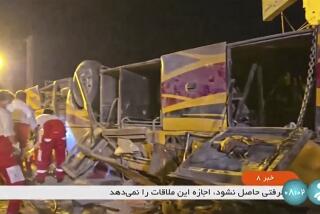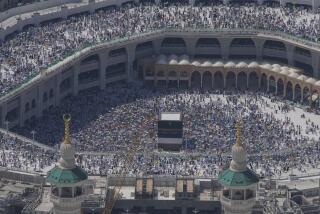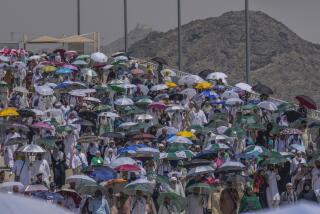RELIGION : Crowds on the Road to Mecca Mark a Political Turnaround
- Share via
NICOSIA, Cyprus — From Tehran, Mashhad, Esfahan and other Iranian cities, planeloads of Muslim pilgrims have begun arriving in Saudi Arabia for the annual hajj to Mecca, marking a political turnaround in the Persian Gulf far more surprising than Iraq’s defeat in the “Mother of All Battles.”
Tehran Radio reported more than 7,000 pilgrims had landed at the enormous hajj terminal in Jidda’s airport at the first of the week. Some have already left for Islam’s holy shrines. More are on their way. The Saudis have authorized 115,000 Iranians to make the pilgrimage this year.
Last year, there were none. A three-year Iranian boycott of the hajj was in full and angry force.
And when disaster struck last year’s pilgrimage--on July 2 more than 1,400 faithful died in Mecca in a panicked stampede in a pedestrian tunnel--Tehran did not hesitate to accuse the Saudi royal family of incompetence and to challenge their stewardship over Islam’s holiest shrines.
Relations between the two Gulf powers had reached a nadir. There was no trust left between the reclusive, reactive Saudi regime and Tehran’s fundamentalist mullahs.
Then, one month after the tunnel disaster, Iraqi President Saddam Hussein’s army invaded Kuwait, turning Gulf politics on its head.
The Saudis opened the door to the U.S.-led Western military coalition. Tehran decried the presence of infidels in the holy land but steered a neutral course, waiting and watching Hussein.
As the conflict moved toward war, Iranian Foreign Minister Ali Akbar Velayati moved through the Gulf and the Middle East, positioning Iran to pick up some of the spoils. Tehran, he said, wanted a piece of the postwar security regime being floated by Washington.
And whatever went on behind closed doors could be measured by Saudi-Iranian attitudes about the hajj.
In the first weeks of July a year ago, the Iranians were using the tunnel disaster like a hammer against a Saudi regime that was still, in Tehran’s eyes, too close to Baghdad. “This is a bitter incident,” said Iranian President Hashemi Rafsanjani of the reports from Mecca. “Those in charge must answer, and the Islamic world must think up a fundamental solution for running the holy shrines.”
The newspaper Jomhori Islami, underlining the division between the Western-influenced Saudis and Iran’s xenophobic hard-liners, called for Mecca and Medina to “be saved from the bloodstained claws of these servants of the United States and Israel.”
The Saudis backpedaled, suppressing the tragedy’s scale for 36 hours. Then, King Fahd seemed determined to dodge responsibility. “It was fate,” he said of the tragedy.
Tehran had boycotted the hajj since 1987, the year political riots broke out in Mecca and more than 400 pilgrims, most Iranians, were killed in clashes with Saudi security forces. Relations snapped completely in 1988 after pro-Iranian saboteurs were accused of bombing a Saudi oil facility.
The 1987 riots began a Saudi practice of assigning quotas on pilgrims. Iran’s was put at 45,000, less than a third of the 150,000 who had gone to Mecca in previous years. Though boycotting the hajj, Tehran continued to haggle over its quota. Last year’s Iranian limit of 45,000 has climbed to 115,000. Diplomatic relations were restored in April.
A corollary to the numbers is the amount of politics the Saudis will permit on the pilgrim trail. The 1987 riots, the Saudis insist, were spurred by demonstrations and incendiary propaganda by agents of the late Ayatollah Ruhollah Khomeini, Iran’s supreme leader. Henceforth, Riyadh ruled, no politics would be practiced on the hajj.
This year, as a measure of growing Iranian influence, a compromise has been struck. The Saudi press agency announced this week that political publications will be banned on the 1991 hajj. But other Saudi press reports said two “disavowal of the infidels” rallies will be authorized, one in Mecca and the other in Medina.
More to Read
Sign up for Essential California
The most important California stories and recommendations in your inbox every morning.
You may occasionally receive promotional content from the Los Angeles Times.










